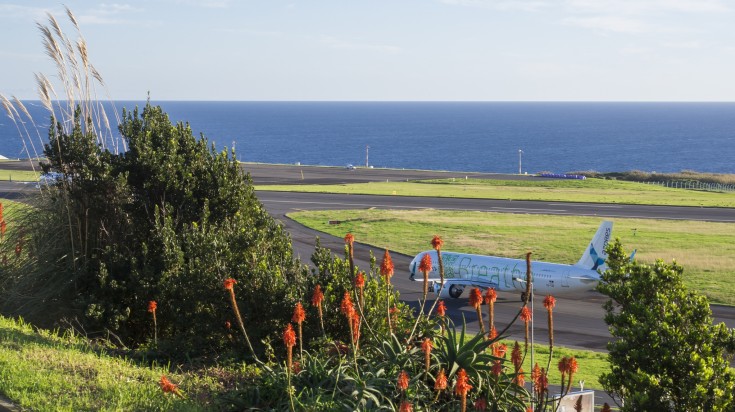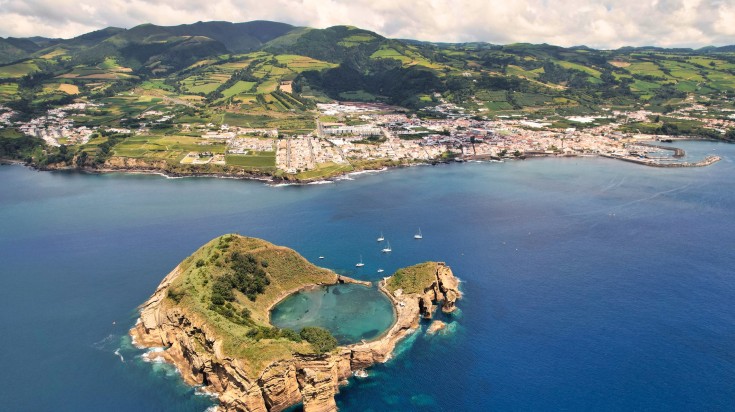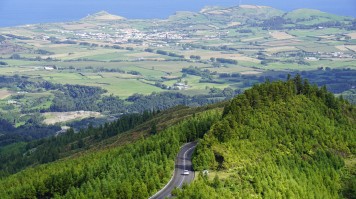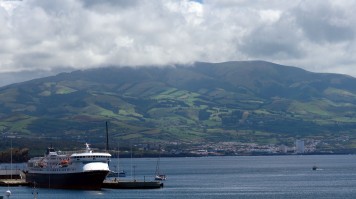How to Get to the Azores: From Portugal and Around the World

- Daniel W.
- From
- Daniel W.
- From
- Julia S.
- From
- Liam R.
- From
Best Azores arrival destinations
There are 3 primary contenders for best points of entry into the Azores:
- João Paulo II Airport (PDL), Ponta Delgada: Ponta Delgada on Sao Miguel Island is the main gateway to the archipelago. João Paulo II Airport, also popularly known as Ponta Delgada Airport, is the largest and busiest airport in the Azores, offering both domestic and international flights.
- Lajes Airport (TER), Terceira Island: Lajes Airport on Terceira Island is the second most important entry point to the Azores. It isn’t as large as João Paulo II Airport, but it still handles a significant amount of inland and international traffic, primarily from European countries.
- Horta Airport (HOR), Faial Island: Less busy than Ponta Delgada and Lajes Airport, Horta Airport still serves as an important entry point for travelers looking to explore the beautiful Faial Island. Horta is a little town with a gorgeous harbor that has long been a stopping point for transatlantic sailors. In addition to its maritime heritage, Horta offers stunning views of neighboring Pico Island, home to Portugal's highest peak, Mount Pico.

Destinations offering direct flights to the Azores
Embarking on an Azorean adventure is easier than you might think, with direct flights connecting this remote paradise to major cities around the world. Below is a list of the 10 most frequented airports with direct flights to the Azores.
- Lisbon, Portugal (Lisbon Airport - Aeroporto Humberto Delgado): LIS
- Ponta Delgada, Azores, Portugal (João Paulo II Airport - Aeroporto João Paulo II): PDL
- Porto, Portugal (Porto Airport - Francisco Sá Carneiro Airport): OPO
- Boston, USA (Boston Logan International Airport): BOS
- Terceira Island, Azores, Portugal (Lajes Airport - Lajes Field): TER
- Toronto, Canada (Toronto Pearson International Airport): YYZ
- Faro, Portugal (Faro Airport - Aeroporto de Faro): FAO
- San Francisco, USA (San Francisco International Airport): SFO
- New York City, USA (John F. Kennedy International Airport): JFK
- Montreal, Canada (Montréal-Pierre Elliott Trudeau International Airport): YUL
Getting to the Azores from Portugal
Since the Azores Islands are an autonomous zone of Portugal (along with Madeira), the easiest and most common way to get to the area is by flying from mainland Portugal. Lisbon, Porto, and Faro are popular departure locations with direct flights to the Azores. It’s pretty straightforward and hassle-free to get the Azores through these direct connections.
Lisbon provides the fastest and easiest route into the Azores from Portugal, with the most frequent flights and shortest duration. TAP Air Portugal and SATA Air Acores airlines offer direct flights between Lisbon and Ponta Delgada lasting around 2 to 2.5 hours.
Getting to the Azores from the UK

Direct flights are available from several popular UK cities such as London, Manchester, and Birmingham.
London is probably the best choice for a starting point because of its extensive flight options, larger airports, and potential for better deals on fares. London Gatwick and Heathrow have the fastest and easiest routes, with flight durations to the Azores averaging around 4 to 5 hours.
TAP Air Portugal, British Airways, and Ryanair offer direct flights from the UK to the Azores, usually offered a few times a week, mostly scheduled for mornings. Fares can range from around USD 130 to 380 (as of May 2024). Alternatively, you can fly via Lisbon or Porto.
Getting to the Azores from North America
- From Canada
Direct flights from Canada to the Azores are limited, but there are other choices. Most major Canadian cities, like Toronto, Montreal, and Halifax, have connecting flights to the Azores through TAP Air Portugal and SATA International airlines, with connections primarily in Europe (usually Lisbon).
Any direct flights will land in Sao Miguel, with the exception of some direct flights available to Terceira in summer.
The total travel time from Canada to the Azores can vary, but on average, expect a journey of 9 to 12 hours including layovers.
- From the USA
Similar to Canada, direct flights from the USA to the Azores are limited. Travelers typically need to connect through European cities like Lisbon and Porto. TAP Air Portugal, SATA International, and Delta Air Lines provide connecting flights from major US states and cities.
The average journey time (including layovers) is 6 to 10 hours from the East Coast and 10 to 14 hours from the West Coast of the US.


Getting to the Azores from Europe
- Spain: The best journey for travelers from Spain to the Azores is through SATA Airlines, with some direct flights available from Barcelona to Ponta Delgada. TAP Air Portugal and Azores Airlines are slightly cheaper options with flights laying over in Lisbon. Flight durations from major Spanish cities to the Azores vary depending on the layover duration but typically range from 4 to 8 hours in total.
- France: The most available option to get to the Azores from France is via flights connecting in Lisbon and Porto. The cheapest flight costs around USD 130, and the quickest option gets you there in just 7 and a half hours. Direct flights are available with limited choices. Charles de Gaulle Airport occasionally offers direct flights at around USD 270. Paris Orly Airport connects indirectly to Terceira and Ponta Delgada in just over 9 hours too.
- Germany: Only connecting flights are available from Germany to the Azores Islands. Flights usually go via Barcelona or major European hubs like Lisbon, Porto, or Amsterdam. Flight durations from German cities to the Azores vary depending on the layover duration but typically range from 6 to 8 hours in total.
- Italy: Direct flights from Italy to the Azores are limited, but travelers can find connecting options usually through Portugal. Flight durations from Italy to the Azores vary depending on the layover duration but typically range from 6 to 9 hours in total.
Tips to fly into the Azores
- Plan ahead for seasonal fluctuations: If you’re traveling to the Azores during the low season (October to April), be prepared for changes in flight timing. Be flexible with your itinerary and take the delays and potential cancellation with zest.
- Comprehensive travel insurance: Given the unpredictability of travel disruptions in the Azores’ wet season, it’s worth getting to grips with offers of more comprehensive travel insurance. See it as added peace of mind. Mitigate potential risks by looking for policies that cover trip cancellations, delays, and other unexpected blips.
Getting around the Azores
Once you are in the Azores, traveling on land is limited to taxi/car services, and traveling between islands is available via ferry or flight.
Inter-island flights offer swift connections for island hopping. SATA Air Azores operates daily routes connecting all nine islands. While most flight times range from 20 minutes to an hour, some routes may have brief layovers on other islands on the way. Sao Miguel is the best-connected place for departures when heading to other islands. Find a full list of inter-island flights here.


Alternatively, ferries provide cheaper travel options between major islands. Ferry services operate multiple times per day around the central Triangle Group of the Azores, though they don’t run year-round (only May through September). Currently, only one ferry company, Atlanticoline, offers sea routes around the islands. Bear in mind the ferry services are more heavily affected than flight services during seasonal weather disruptions.
Car rentals and taxi services are great options when staying on land. Local agencies provide diverse vehicle options. For those preferring eco-friendly travel, public buses serve major towns and tourist sites on most islands. While this might limit your availability to get to the hidden corners of the island, it might also heighten an adventurer’s spirit!
Insider tip: Island-hopping requires a little bit of planning as not all of the islands have direct flights to ferries between them. For example, Santa Maria, which is next to São Miguel, only has direct flights to São Miguel, as there is no longer an inter-island ferry. If you want to visit Santa Maria, you'll need to come back via São Miguel in order to get to the next island. Azores Airlines allows you to easily book connecting flights, however, it's worth checking if the connection requires an overnight stay as this will increase your travel costs.
Travelling by ferry is, unsurprisingly, cheaper. If you're on a budget, sticking to the triangle (Faial, Pico, and São Jorge) as well as Graciosa and Terceira would be the cheapest islands to visit as all are connected by ferry. However, it's important to note that some ferries don't run every day, so check the timetables on Atlânticoline beforehand. – James Cave from Portugalist
Let us handle the tricky logistics
Here at Bookmundi, our business is to take the hassle out of your travel plans, giving you more time to enjoy the journey. Our trusted travel experts know the islands inside and out, and can help you plan and organize a customized trip to the Azores.

















